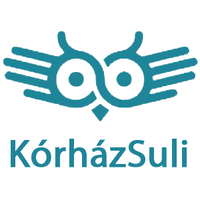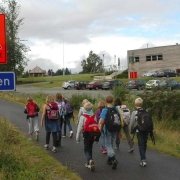Hospiedu (Kórházsuli) – Supporting children out of school for longer periods
Excerpt
Hospiedu (Kórházsuli) is an individualised learning support programme that partly uses gamified, IT-based activities to ensure children prevented from going to school for longer periods, mostly by illness, catch up with their peers. It allows these children to go back to school after recovery and complete their studies.
Narrative, origins and objectives of the initiative
What kind of project is this? Please give a short description (summary) of it.
Hospiedu (Kórházsuli) offers individualised learning material and personal learning support to children that are in hospital with somatic or mental illnesses. The same support is offered to children that are not hospitalised, but undergo treatment or are in recovery, possibly for years. These children officially have home-schooled status, and receive only a little support while in hospital and no support when at home. The project works with two types of volunteers: type one are mostly university students that work directly with children helping them in their learning. Type two are mostly secondary school students developing learning material adjusted to the needs of these children. The basic framework relies on a certain level of cooperation between the programme and the school – most often informal – to ensure that children not attending school can follow the same curriculum their classmates do. This means that material is developed and introduced individually and according to the needs of the given child. Material developed become part of a data bank and re-used. Their individualised approach makes it possible for children who has already been out of school for some period and severely lag behind to catch up on their studies.
Please tell us why, in general, this project is considered a successful one?
Experience of participants shows that on the one hand children supported in the programme learn much more effectively than before, but on the other hand it is also a valuable learning experience for supporting students according to their reports. Another important element of success is that the programme is based on peer support that provides peer community experience that children with serious illness often lack since they are mostly helped by adults. Success can also be measured in numbers. Since the start of the programme in 2015 the number of both participating children and supporting volunteers has grown. In the beginning there were 20 volunteers working with only 4 children, and in the school year of 2017/2018 120 children were supported by 250 volunteers.
And why would you consider it a grass-roots initiative?
The initiative was started and designed by a hospital teacher and some secondary school teachers.
What challenges needed to be solved in this project?
The most important systemic challenge is to win the cooperation of the schools their mentees are enrolled at. Schools are not even aware of children who are not at school due to illness.
Another main challenge is to ensure sustainability by finding a way to receive regular funding. Currently a lot of effort is put into fundraising, while they basically cater for the education needs of children of compulsory schooling age. State funding should be in line with this. Funding is also crucial for ensuring the right management structure for a growing initiative. While they are planning to double the number of participants, their management is already overworked.
Is this initiative based on any particular theoretical framework? Which one?
No theoretical basis was used for developing the programme.
(Appendix) Is your intervention standing on its own or is it a part of a bigger and more holistic approach?
The approach itself is holistic taking into account the individual needs and characteristic of each supported child, but also of the volunteers. For the university student volunteers it becomes an important part of their training, although it is not officially recognized by teacher training institutions.
Please describe the group(s) intended as beneficiaries of this initiative
Why has this group (have these groups) been chosen?
They started the programme with the aim of offering support to children at an oncology ward, but since then they have widened the programme to children with various somatic as well as psychological conditions. When in hospital, children in Hungary receive a certain amount of teaching, but this has no professional standards or real quality requirements. This results in low quality service, while they usually need more individual support and more modern methodology. Gamification and the use of IT in general makes studying a desirable activity for them. This is why education support for children who cannot attend school as a result of their condition, whether in hospital or not, did not exist before Hospiedu started.
Could you please tell us something about the relative size of the (of each) target group, within the school/university population, region and/or country?
Statistical data is not definitive, but their estimation is that about 2-3,000 children are home-schooled due to somatic illness, and an even higher number of children due to psychological conditions. Families with children with ADHD or autistic spectrum disorder in Hungary are forced to do home-schooling.
Which social characteristics are taken into account and what is the geographical area covered?
This is a very special population coming from all socio-economic groups. The programme is implemented nationally in Hungary.
On which level is the project implemented?
National level
Please describe the political and socio-economic factors that you believe have been important enablers for your initiative
Did the initiative have political support?
Children not attending school due to illness are not identified by policy as a target group. The programme leaders are working pro-actively on putting this on the policy agenda. At the same time programmes with an inclusion focus are not supported by national policy and government politicians. They would like to make educational rehabilitation part of the general rehabilitation policy.
How did it fit with local, regional or national policies?
It does not fit any policy trends on these levels.
Who are the stakeholders supporting the initiative?
For success they need the support of hospitals, schools where the children are enrolled, parents, volunteers, secondary schools where volunteers study as well as funders.
Are there particular demographic changes present that are influencing the project?
Although they started working with children with somatic illness and hospitalised for certain periods of time, they soon realised that there are children who are not in hospital, but still need educational support while recovering at home. On the other hand, the number of children not attending school due to mental conditions is growing. These children often need more effort to achieve desired learning outcomes.
What is the institutional strategy and culture of the (educational) organization?
The foundation implementing the programme works with a highly collaborative approach. Their goal is to work with their volunteers for a long time, and thus highlight and recognise volunteer effort and achievement. They would like to put their target groups on the policy agenda so that their work can become part of the system.
To what extent does the initiative have an influence on institutional policy (or potential influence) of the (educational) organization?
The foundation was established for carrying out the programme, so institutional policy is built for it. At the same time, they see a certain change in institutional policy and culture of the partner institutions – both schools and hospitals – they work with.
(Appendix) Is there public support for your initiative and the issue it addresses?
Working with ill children attracts public support both in the form of offering volunteer effort and financial support.
(Appendix) What other factors do you think have been important for the success of this initiative?
Collaboration between secondary schools providing student volunteers and the foundation is an important success factor. Volunteers feeling a sense of achievement and of doing good are motivated.
Please describe the overall initiative design and the methods and tools used to reach the goals
Please describe the specific activities carried out.
Each individual support project starts with reaching out to the child at hospital or recovering at home. In this first phase they not only ‘enroll’ the child, but also work with the parents to gain their support.
The programme works with university student volunteers who each support a child in certain subjects. They work in pairs and not only support the child, but also each other. Before starting to work with these children, they receive a special training session to prepare them. They need to know what to expect in the hospital environment, as well as what they may face when working with seriously or even terminally ill children.
Another group of volunteers come from secondary schools. They support the work of those regularly meeting the child by developing learning material form them. They develop it for a Moodle platform where material is used and re-used.
They have been pushed to find ways for secondary school volunteers to meet children. As the hospital environment is considered psychologically risky, not they also work with blind and disabled children to offer meeting opportunities for this volunteer group, too, upon request.
The foundation trains volunteers, coordinates the work with children, offers support and supervision. They also support their mentees in returning to their original class when they recover enough.
What were the key roles (teacher, student, management team etc.) within the project?
Hospital: identifies children and links them with the programme
School: offers information on the general leaning goals and curriculum of the original class of the child, negotiates about requirements to recognise learning supported by Hospiedu and give grades, and in ideal cases offers the possibility to return to the class gradually
Parents: understand the importance of learning and catching up with peers regardless the illness, collaborate with the programme, especially when supporting children recovering at home
University student volunteers: offer individualised face-to-face learning support in certain subjects and study areas according to their expertise and interest
Secondary school volunteers: utilise their own learning and develop learning material on topics identified and requested for each child
Foundation: plans, manages, supervises and coordinates the work, as well as train, coordinate, evaluate and reward volunteers, establish collaboration of hospitals and schools, offer sensitisation for the class where the ill child belongs, raises funds, and communicates about their work
What ideas, tools, theories, models, methodology (etc.) have been used to reach the goals?
Online training / Moodle
Individualised learning
Methodologies to work with ill children
What are the final revenues of the project?
Their individualised learning methodology has proven to lead to the academic success of children. Children who are ill need not only more attention, but also more effort, but the methodology can be beneficial for all children. If a target group is boring, lessons or teaching will trigger immediate rejection. For the university students who are pre-service teachers, this is an experience they can utilise when they start teaching after graduating.
They have also experienced that successful learning also depends on the relationship between ‘teacher’ and ‘student’, as some pairings do not work. This is something that needs to be recognised and tackled, but this experience can also be translated to other learning-teaching relationships.
Please describe if your project ensured its sustainability
If so, how did you ensure the short-term impact of the project?
The short term impact is ensured by close supervision and collaboration within teams, working closely with the parents and the school of the child. Recognition of volunteer effort is an important element. Their work is currently funded by private funders only, relying on two companies as main funders and a number of smaller ones.
And how did you ensure the long-term impact of the project?
Growing support by both funders and volunteers seems to offer a good basis for the long-term impact in general. The aim is to work with as much of the target group as possible, but on the long run funding by the state would be necessary.
To ensure volunteer support, recognition of their effort is crucial. Training, opportunities to participate at conferences, study visits and similar opportunities are important to establish their long-term commitment.
The long term impact on the side of the mentees depends on the relationship between the programme, the original school of the child and the parents to ensure smooth transition back to school. In case of re-occurring conditions this cooperation is essential.
Has your project been replicated elsewhere?
The programme originally started with a specific target group of children in oncology treatment. To a certain extent they replicated and adapted the programme for other target groups: children with disabilities and children with mental rather than somatic conditions.
Please tell us about the resources used in this initiative
What was the budget for the initiative?
The annual budget of the programme is currently about 50,000 Euros
How much did the initiative depend on volunteers?
The initiative fully depends on volunteers.
How were the costs perceived by the public/the sector/other stakeholders?
Their two main funders regularly participate in their work and recognise that their funds are well-invested. Smaller funders' feedback is very limited, but they usually keep offering funding, so the assumption is that they consider the costs and the way funding is used acceptable.
To what extent did the initiative achieve its objectives?
Please describe the evidence to support the success of your initiative.
The most important evidence is the school success of children they work with. Success is when they manage to continue their schooling without repeating a year or when they do well at final exams.
Another important evidence of success is in the testimonies and feedback from volunteers as the programme is based on recognising their learning as well as of their mentees.
Did the intervention lead to any unintended (positive) outcomes?
Not that they are aware of.
What indicators (quantitative and qualitative) have you measured to demonstrate success?
- number of children supported
- school success of children participating
- volunteer achievement and experience
- parents’ feedback
(Appendix) How did you evaluate/monitor this intervention?
The work of volunteers is closely monitored by the foundation’s management team. University student volunteers also act as supporters and quasi-mentors of secondary school volunteers. Regular supervision is also part of the programme. Each case is discussed by professionals and volunteers on a regular basis.



 Sale für Alle 2018
Sale für Alle 2018

 Caritas Wien/Stefanie Starz
Caritas Wien/Stefanie Starz

